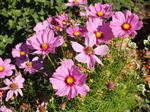
Cosmos
Family: Asteraceae (Compositae)
Genus: Cosmos
Common Name: Purple Mexican Aster
Origin: South-western USA to tropical America and Mexico.
Appearance: White, purple, pink or seldom yellow flowers with radiate flower heads. Leaves finely dissected.
Culture: Ordinary soil. Warm position. Not frost-hardy. Water well in hot, dry weather. Deadhead regularly.
Propagation: Seed. Will often self-seed if dried heads left.
Health: Usually no problems, but occasional infestations of red spider mite or aphids.
Uses: Borders, pots, cottage gardens. Butterfly and bee attractant.
Cultivars/Species: 20+ species. Common garden Cosmos is C. bipennatus. Cultivars are many and varied. Examples are ‘Purity’, ‘Dazzler’, ‘Antiquity’, ‘Rose Picotee’, ‘Seashells’.
This is from our new ebook
Growing & Knowing Annuals.